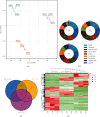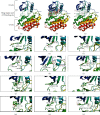Identification of Bioactive Components of Stephania epigaea Lo and Their Potential Therapeutic Targets by UPLC-MS/MS and Network Pharmacology
- PMID: 35529936
- PMCID: PMC9068296
- DOI: 10.1155/2022/3641586
Identification of Bioactive Components of Stephania epigaea Lo and Their Potential Therapeutic Targets by UPLC-MS/MS and Network Pharmacology
Abstract
Stephania epigaea, an important traditional folk medicinal plant, elucidating its bioactive compound profiles and their molecular mechanisms of action on human health, would better understand its traditional therapies and guide their use in preclinical and clinical. This study aims to detect the critical therapeutic compounds, predict their targets, and explore potential therapeutic molecular mechanisms. This work first determined metabolites from roots, stems, and flowering twigs of S. epigaea by a widely targeted metabolomic analysis assay. Then, the drug likeness of the compounds and their pharmacokinetic profiles were screened by the ADMETlab server. The target proteins of active compounds were further analyzed by PPI combing with GO and KEGG cluster enrichment analysis. Finally, the interaction networks between essential compounds, targets, and disease-associated pathways were constructed, and the essential compounds binding to their possible target proteins were verified by molecular docking. Five key target proteins (EGFR, HSP90AA1, SRC, TNF, and CASP3) and twelve correlated metabolites, including aknadinine, cephakicine, homostephanoline, and N-methylliriodendronine associated with medical applications of S. epigaea, were identified, and the compounds and protein interactions were verified. The key active ingredients are mainly accumulated in the root, which indicates that the root is the main medicinal tissue. This study demonstrated that S. epigaea might exert the desired disease efficacy mainly through twelve components interacting via five essential target proteins. EGFR is the most critical one, which deserves further verification by biological studies.
Copyright © 2022 Xingyu Li et al.
Conflict of interest statement
The authors declare that there are no conflicts of interest regarding the publication of this paper.
Figures






Similar articles
-
Integrating UPLC-MS/MS with in Silico and in Vitro Screening Accelerates the Discovery of Active Compounds in Stephania epigaea.J Pharm Biomed Anal. 2024 Sep 15;248:116289. doi: 10.1016/j.jpba.2024.116289. Epub 2024 Jun 13. J Pharm Biomed Anal. 2024. PMID: 38901158
-
Xiao-Luo-Wan treats propylthiouracil-induced goiter with hypothyroidism in rats through the PI3K-AKT/RAS pathways based on UPLC/MS and network pharmacology.J Ethnopharmacol. 2022 May 10;289:115045. doi: 10.1016/j.jep.2022.115045. Epub 2022 Jan 29. J Ethnopharmacol. 2022. PMID: 35101570
-
Systematic Evaluation of the Mechanisms of Mulberry Leaf (Morus alba Linne) Acting on Diabetes Based on Network Pharmacology and Molecular Docking.Comb Chem High Throughput Screen. 2021;24(5):668-682. doi: 10.2174/1386207323666200914103719. Comb Chem High Throughput Screen. 2021. PMID: 32928080
-
Identifying cancer-related molecular targets of Nandina domestica Thunb. by network pharmacology-based analysis in combination with chemical profiling and molecular docking studies.J Ethnopharmacol. 2020 Mar 1;249:112413. doi: 10.1016/j.jep.2019.112413. Epub 2019 Nov 21. J Ethnopharmacol. 2020. PMID: 31760157
-
Identifying the active compounds and mechanism of action of Banxia Xiexin decoction for treating ethanol-induced chronic gastritis using network pharmacology combined with UPLC-LTQ-Orbitrap MS.Comput Biol Chem. 2021 Aug;93:107535. doi: 10.1016/j.compbiolchem.2021.107535. Epub 2021 Jun 25. Comput Biol Chem. 2021. PMID: 34217946
Cited by
-
Identification and Characterization of Two Se6OMTs from Stephania epigaea Offer Novel Insights into the Biosynthetic Pathway of Cepharanthine.Metabolites. 2025 Feb 3;15(2):92. doi: 10.3390/metabo15020092. Metabolites. 2025. PMID: 39997717 Free PMC article.
References
-
- Wu Z., Raven P. H., Hong D., Missouri Botanical Garden . Flora of China . Vol. 1. Beijing, China: Science Press; 1996.
LinkOut - more resources
Full Text Sources
Research Materials
Miscellaneous

